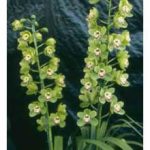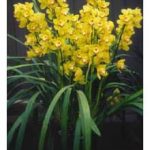Many ingredients are suitable for potting mixes as is shown by the wide variety in use. This results from availability, cost, personal preference, etc. However to be adequate, a potting mix must meet certain criteria.
The potting mix must support the plant, provide a suitable environment for the roots so they can absorb water and nutrients, and must not produce or absorb any toxic substances. Most have adequate supporting properties once a reasonable root system is developed, so this is rarely a problem. More important are the physical properties over the life of the compost. These will vary with the choice of materials, their preparation, cultural practices and the time between pottings.
Generally a period of two to three years is required between pottings, so that materials must remain essentially stable for this time. Barks, gravel, wood shavings, rice hulls etc., are typical ingredients that are used, whereas composted leaves, manures, etc., break down rapidly and are thus unsuitable.
Raw materials generally are not suitable immediately without some treatment. This applies especially to organic components such as barks and wood shavings. In their raw state they contain numerous compounds that must be changed or removed before healthy root growth is possible. The composting micro-organisms provide the mechanism for this by breaking down these toxic products, but to work effectively the organisms require an adequate and readily available source of nitrogen. The organisms are universally present and there is no need to add them specifically for composting. The addition of a small amount of old compost will suffice. However a nitrogen source, such as urea or ammonium nitrate, is essential to facilitate the composting process and nitrogen is the only essential additive. Lime is often mentioned. It will change the colour of bark and remove the raw pine smell, but does not assist composting and indeed may be detrimental by raising the pH excessively. If the addition of calcium is desired, it should be in the form of gypsum (calcium sulphate), which does not alter the pH. It is best to allow about six weeks for composting, at which time the nitrogen drawdown should be minimal. Ageing allows the composting process to proceed without any outside assistance. This is considerably slower and less effective than active composting.
Chemical additives may be included in the composted mixes as specific food sources for the plant following potting. These include low solubility substances such as IBDU (isobutylidene urea) for nitrogen, lime and dolomite for calcium and magnesium, superphosphate for phosphorous and fritted trace elements. Slow-release products such as Osmocote® and Nutricote®, in which a membranous resin coat controls release rates of the enclosed chemicals, are also used by some growers. Others use animal manures, which I believe should be avoided because they tend to interfere with the physical characteristics of the mix and are difficult to assess objectively. At Atlantis Orchids we compost our bark fully and then rely entirely on liquid feeding, as we consider this gives the best control over growth and flowering.
Of particular importance is the air capacity and the ability of the compost to provide a constant water contact with the roots. Roots require a constant supply of oxygen to remain healthy, so that composts must be of a suitable particle size to allow for this. With the root tips being solely responsible for water and nutrient absorption, particle size is again important, to assure that an adequate amount of water and dissolved nutrients are available when required.
Many different growers get excellent results using a wide variety of potting mixes. There is no special secret ingredient that must be present. It is simply essential to follow the principles discussed above. Healthy root growth results in healthy top growth and this is only possible in a suitable potting compost.

